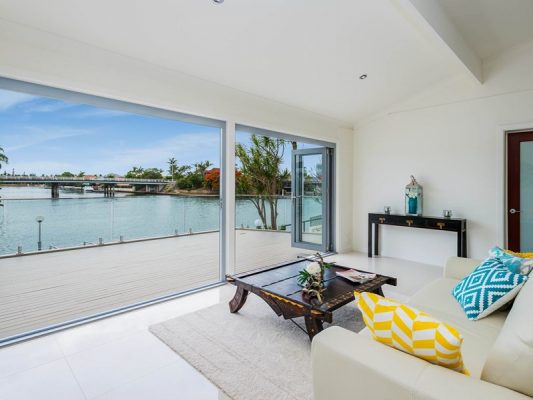
There are a range of glazing options available that can deliver a broad range of functional and aesthetic benefits to your custom new home depending on your budget and requirements. Whether your priority is energy efficiency, privacy, security or purely aesthetic, advances in technology and construction methods have made it possible to achieve more customisation in windows, giving you greater flexibility to realise the unique design and style preferences for your custom new home. In this guide, we will explore and compare glazing options that are most commonly used by our clients.
Standard Clear Glazing
Standard clear glass provides unparalleled clarity, high transparency and excellent light transmission. While it is the most affordable glazing option, it does not offer significant thermal, security, UV or sound reduction performance. Standard clear glass is frequently used by volume builders as one of their ‘standard inclusions’.
Double Glazing
A double-glazed window has two sheets of glass with a small gap in between them that is filled with argon gas. It is the most energy efficient glazing option on the market and can improve the thermal and sound insulation of your home by at least 70%. While it is a more expensive option to install, its thermal performance will naturally regulate the temperature in your new home to significantly reduce the need for artificial heating and cooling. Thanks to its thermal efficiency, double glazing gives architects and designers the freedom to use larger, feature style windows while still achieving the required energy star ratings for new homes.
Low E Glass
Low-E glass windows have a transparent low emissivity coating that reflects heat while still allowing in maximum light, helping keep your home cooler in summer and warmer in winter. The low-e coating also works to block the transmission of UV rays, helping to minimise sun damage to furniture, carpets and other soft furnishings. While low-e glass does not offer the same thermal and sound insulation as double-glazing, it offers a more affordable alternative and significantly outperforms standard clear glass.
Laminated Glass
Laminated glass is made up of two panes of glass bonded together with a layer of polyvinyl butyral in the middle. While it does offer some sound insulation and UV protection, the biggest benefit of laminated glass is its safety. If glass shatters or breaks, it is held together by the internal layer, making it a popular option for use in bathrooms, glass railings, roof windows and skylights. Because it is much harder to break, laminated glass is also considered one of the more secure glazing options, with much harder, more consistent force needed to penetrate the glass. Standard laminated glass won’t offer your home great insulation properties, but this can be enhanced by using a different type of laminate.
Textured Glass
Textured glass is a great option when you are looking for both light diffusion and privacy in a space. One side of the glass is usually patterned with the level of privacy customisable from 5 different gradient options, while the other side is usually left smooth. The pattern is also customisable and can be used as a decorative feature with contemporary and classic options to compliment the styling of your new home. Textured glass can also be laminated or toughened to enhance its safety and security performance. While it is not a great insulator on its own, it can be incorporated into insulating glass units for improved thermal and sound insulation performance.
Translucent Glass
Translucent glass is made by binding two panes of glass together with a white translucent interlayer. The effect is a crisp, white frosted appearance which scatters and diffuses light, completely blurring and obscuring the scenery behind. Commonly used in bathrooms, this is a very effective option in spaces where privacy and light diffusion are both important considerations. It also offers great UV screening and some enhanced noise insulation, as well as being a grade A safety glass.
A Final Note on Glazing
The different performance that is offered by the various types of glazing options often means you will use 2 or 3 glazing types for specific purposes and spaces in your custom new home. Chat to the team at Renmark Homes today about how you can maximise the performance of your glazing to compliment the style and function of your custom new home.
